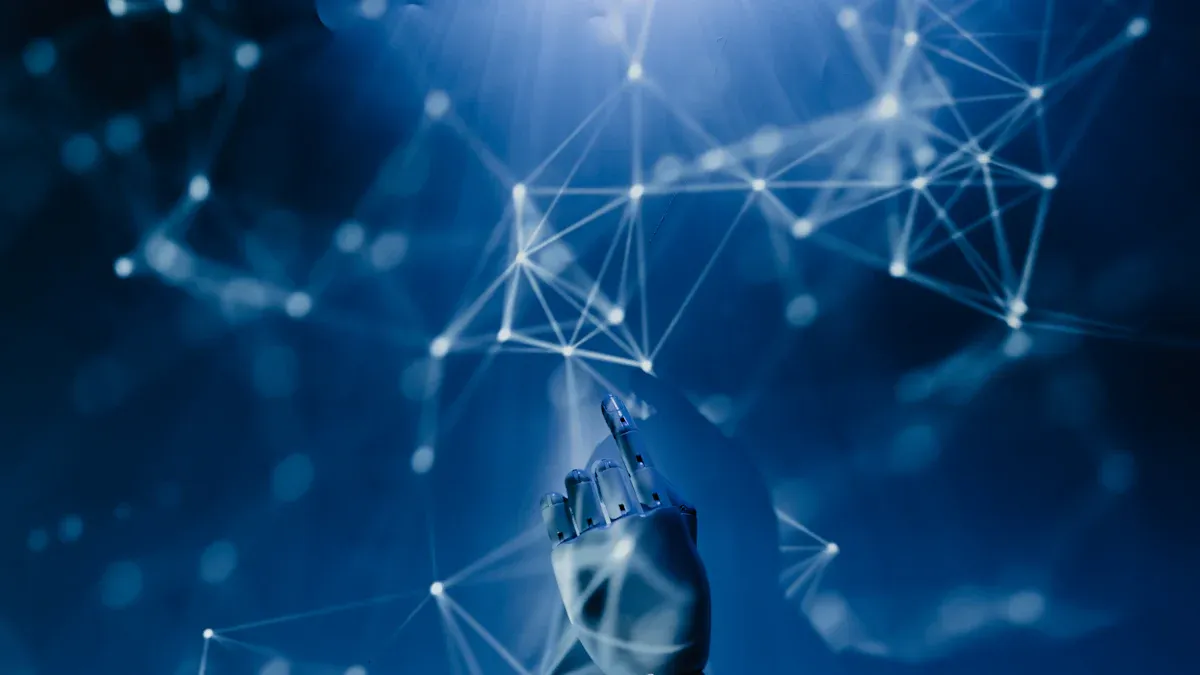
An AI model is a computational framework that enables machines to learn, reason, and make decisions. It forms the backbone of artificial intelligence by allowing systems to process data and generate predictions or insights. There are five main types of AI models: supervised learning, unsupervised learning, reinforcement learning, deep learning, and hybrid models.
Understanding these types of AI models is crucial as their applications drive innovation across industries. For example:
-
75% of generative AI users aim to automate tasks, showcasing its role in boosting productivity.
-
Companies using AI report a 22% reduction in process costs, highlighting its economic impact.
-
The global AI market, valued at $208 billion in 2023, is expected to surpass $1.8 trillion by 2030, reflecting its rapid growth.
By grasping the potential of these models, you can unlock opportunities to improve efficiency and profitability in your field.
Key Takeaways
-
AI models help machines learn and make choices, boosting progress in many industries.
-
Supervised learning models use labeled data to predict accurately, helping areas like banking and health care.
-
Unsupervised learning models study unlabeled data to find hidden patterns, improving knowledge in marketing and online safety.
-
Reinforcement learning teaches agents to decide using rewards, improving robots and self-driving systems.
-
Hybrid AI models mix methods, adding human smarts for better decisions and creative ideas.
Supervised Learning Models

Definition and Overview
Supervised learning models are a type of AI model where you train the system using labeled data. Each input in the dataset corresponds to a specific output, allowing the model to learn patterns and relationships. These models excel at tasks like classification and regression, where the goal is to predict outcomes based on historical data. By leveraging supervised learning, you can create AI systems capable of making accurate predictions and decisions.
Examples of Supervised Learning Models
Supervised learning encompasses a variety of machine learning models, each tailored to specific tasks. Here are some notable examples:
|
Industry |
Project Idea |
Source Code |
|---|---|---|
|
Financial Services |
Loan eligibility prediction using various personal and financial attributes. |
|
|
Multiple |
Inventory demand forecasting using algorithms like Bagging and XGBoost to predict customer demand. |
|
|
Real Estate |
Real estate price prediction based on property attributes using techniques like Linear Regression and Regularization. |
Build Real Estate Price Prediction Model with NLP and FastAPI |
These examples highlight the versatility of supervised learning across industries. Whether you aim to predict loan eligibility or forecast inventory demand, these models provide practical solutions.
Applications in Real-World Scenarios
Supervised learning models have transformed industries by enabling precise predictions and actionable insights. In healthcare, these models have reduced mortality rates by 20% through early intervention for sepsis. In banking, they have decreased fraudulent losses by 30%, fostering greater customer trust.
You can also find applications in retail, where AI models optimize pricing strategies and inventory management. In transportation, supervised learning powers route optimization and demand forecasting. These applications demonstrate the immense potential of AI in solving real-world challenges.
Unsupervised Learning Models
Definition and Overview
Unsupervised learning models operate on unlabeled data, making them distinct from other types of AI models. These models identify patterns, relationships, and structures within datasets without predefined outputs. You can use unsupervised learning to uncover hidden insights that might otherwise remain unnoticed.
Some common algorithms include:
-
Clustering: Groups data into clusters based on similarities, helping you understand natural groupings.
-
Association Rule Learning: Discovers associations between variables, often applied in market basket analysis.
-
Dimensionality Reduction: Simplifies datasets by reducing features while retaining essential information.
These techniques empower you to analyze complex datasets efficiently, paving the way for innovative applications across industries.
Examples of Unsupervised Learning Models
Unsupervised learning models have proven their versatility in various sectors. For instance:
-
In healthcare, these models analyze genetic data and medical imaging to identify early signs of diseases.
-
In finance, anomaly detection algorithms pinpoint fraudulent transactions, safeguarding assets.
-
In cybersecurity, unsupervised learning detects unusual patterns that may signal security breaches.
By leveraging these models, you can address challenges in diverse fields, from improving patient outcomes to enhancing digital security.
Applications in Real-World Scenarios
Unsupervised learning models have revolutionized industries by enabling data-driven decision-making. Here are some notable applications:
|
Industry |
Application |
|---|---|
|
Healthcare |
Clustering techniques for grouping patients with similar symptoms; PCA for genomic data analysis. |
|
Finance |
Anomaly detection in fraud prevention; clustering for risk management based on client behaviors. |
|
Retail |
Market segmentation through clustering; dimensionality reduction for sales trend visualization. |
|
Telecommunications |
Anomaly detection for network monitoring; clustering for optimizing resource allocation. |
For example, in retail, you can use clustering to segment customers based on purchasing behavior, enabling personalized marketing strategies. In telecommunications, anomaly detection helps monitor networks for irregularities, ensuring seamless service delivery. These applications demonstrate the transformative power of unsupervised learning in solving complex problems.
Reinforcement Learning Models
Definition and Overview
Reinforcement learning (RL) is a branch of machine learning that focuses on training intelligent agents to make decisions in dynamic environments. Unlike supervised learning, RL does not rely on labeled input-output pairs. Instead, it uses a reward system to guide the agent's actions. The goal is to maximize cumulative rewards over time.
In RL, the environment is often modeled as a Markov Decision Process (MDP). This framework helps the agent decide its next action based on the current state and potential outcomes. RL algorithms are categorized into two main types:
-
Model-based RL: The agent builds an internal model of the environment to predict outcomes.
-
Model-free RL: The agent learns through trial and error without creating a model.
Early computational models, such as the Rescorla-Wagner model, laid the foundation for RL by mathematically explaining learning processes. Today, RL plays a vital role in advancing artificial intelligence by enabling agents to learn autonomously through exploration and exploitation.
Examples of Reinforcement Learning Models
Reinforcement learning has led to groundbreaking achievements in AI. Some notable examples include:
-
AlphaGo: This AI defeated world champion Lee Sedol in the game of Go by combining Monte Carlo Tree Search with RL techniques.
-
OpenAI Five: A team of AI agents that mastered the video game Dota 2 using Proximal Policy Optimization and self-play strategies.
-
AlphaStar: Achieved Grandmaster status in StarCraft II by employing deep reinforcement learning and multi-agent systems.
-
DeepStack: An AI that excelled in No-Limit Texas Hold’em poker by integrating deep learning with game theory.
-
Hide and Seek: A simulation where agents learned complex strategies in a physics-based environment.
These examples highlight the versatility of RL in solving complex problems and achieving human-level performance in various domains.
Applications in Real-World Scenarios
Reinforcement learning models have practical applications across industries. In robotics, RL enables robots to learn tasks like object manipulation and navigation. In healthcare, RL optimizes treatment plans by balancing risks and benefits. Autonomous vehicles use RL to improve decision-making in real-time traffic scenarios.
In finance, RL helps optimize trading strategies by analyzing market trends and adapting to changing conditions. Video game developers use RL to create intelligent non-player characters (NPCs) that adapt to players' actions. These applications demonstrate how RL enhances the capabilities of AI systems, making them more adaptive and efficient.
By leveraging reinforcement learning, you can develop AI models that excel in dynamic and uncertain environments, unlocking new possibilities for innovation.
Deep Learning Models

Definition and Overview
Deep learning models are a subset of AI models that mimic the structure and function of the human brain through neural networks. These models consist of multiple layers of interconnected nodes, where each layer processes data and passes it to the next. This layered architecture enables deep learning to excel at recognizing patterns and making predictions from large datasets.
The foundational principles of deep learning emphasize the importance of linking models to real-world phenomena. For example, Schelling’s model demonstrated that without empirical evidence, models cannot effectively explain or enhance understanding. To build effective deep learning models, you should:
-
Conceptualize the input and output before training.
-
Define what the trained model represents.
-
Connect the model’s representation to underlying mechanisms using additional knowledge.
Zednik highlights the significance of linking deep learning models to their external target phenomena, ensuring their relevance and accuracy.
Examples of Deep Learning Models
Deep learning models power many AI applications across industries. Some examples include:
-
Customer Support: AI agents that understand customer intent and detect sentiment.
-
Healthcare: Tools for automatic transcription, symptom checkers, and intelligent triage assistants.
-
Banking and Fintech: Systems for fraud detection, automated support, and personalized communication.
-
Education: Adaptive learning paths and intelligent tutoring systems for personalized education.
These examples showcase how deep learning models transform industries by automating tasks and improving decision-making.
Applications in Real-World Scenarios
Deep learning models have revolutionized real-world applications. In logistics, they reduce inventory costs by 20% and improve on-time delivery rates. In finance, they enhance fraud detection and risk assessment, providing valuable insights for stock market predictions and automated trading.
|
Application |
Before Implementation |
After Implementation |
|---|---|---|
|
Fraud Detection |
N/A |
Improved identification of fraudulent activities |
|
Risk Assessment |
N/A |
Enhanced decision-making |
|
Stock Market Prediction |
N/A |
Valuable investment insights |
|
Automated Trading |
N/A |
Increased efficiency and profitability |
Additionally, industries report a rise in defect detection rates from 75% to 95% and a reduction in maintenance costs by $300,000 annually. These advancements highlight the transformative potential of deep learning in solving complex challenges.
Hybrid AI Models
Definition and Overview
Hybrid AI models combine multiple AI approaches, such as supervised learning, unsupervised learning, and reinforcement learning, to create systems that leverage the strengths of each method. These models also integrate human intelligence, enabling collaboration between humans and AI systems for better decision-making.
Hybrid intelligence emphasizes teamwork, where AI acts as an active participant rather than a passive tool. This approach fosters dynamic dialogues between humans and AI, ensuring shared responsibilities and improved outcomes. The table below outlines key concepts related to hybrid AI models:
|
Key Concept |
Description |
|---|---|
|
Hybrid Intelligence |
A collaborative approach between humans and AI systems in decision-making processes. |
|
Collaboration |
Defined as a joint effort towards a common goal, involving team dynamics and shared responsibilities. |
|
Role of AI |
AI is viewed as an active team member rather than just a tool, engaging in dynamic dialogues with humans. |
By understanding these principles, you can explore how hybrid AI models enhance generative capabilities and automation across industries.
Examples of Hybrid AI Models
Hybrid AI models have been implemented in various fields to address complex challenges. For instance:
-
A hybrid AI model in education integrates environmental analysis and machine learning to predict the quality of AI education.
-
In healthcare, hybrid systems combine generative AI models with human expertise to improve diagnostic accuracy.
-
In finance, hybrid models optimize trading strategies by blending generative AI with human decision-making.
These examples demonstrate the versatility of hybrid AI models in solving real-world problems.
Applications in Real-World Scenarios
Hybrid AI models offer transformative applications across industries. In education, these models personalize learning experiences by combining generative AI models with human insights. In healthcare, hybrid systems enhance patient care by automating routine tasks while allowing human experts to focus on critical decisions.
In manufacturing, hybrid AI models improve defect detection rates by integrating generative AI with human oversight. In customer service, these models enable intelligent automation, reducing response times and improving user satisfaction. By leveraging hybrid AI models, you can achieve a balance between automation and human expertise, unlocking new possibilities for innovation.
AI models have revolutionized how industries approach problem-solving. From supervised learning to hybrid AI models, each type offers unique capabilities that address specific challenges. For instance, variational autoencoders excel in image generation, while large language models transform natural language processing. Hybrid AI models combine strengths from various approaches, enabling solutions for complex, real-world scenarios.
Understanding these models allows you to harness their potential effectively. Whether improving healthcare diagnostics, optimizing supply chains, or enhancing customer experiences, AI empowers you to innovate and adapt. By exploring AI further, you can unlock opportunities to drive growth and efficiency in your industry.
AI is not just a tool; it’s a transformative force shaping the future. Start leveraging its power today to stay ahead in a rapidly evolving world.
FAQ
What is the difference between supervised and unsupervised learning models?
Supervised learning uses labeled data to predict outcomes, while unsupervised learning identifies patterns in unlabeled data. You can use supervised models for tasks like classification and regression, whereas unsupervised models excel at clustering and dimensionality reduction.
How do reinforcement learning models work?
Reinforcement learning models train agents to make decisions by rewarding desired actions. You can use these models to optimize strategies in dynamic environments, such as robotics or autonomous vehicles.
What are hybrid AI models, and why are they important?
Hybrid AI models combine multiple approaches, like supervised and unsupervised learning, to leverage their strengths. They improve ai model applications by integrating human intelligence, enabling better decision-making and adaptability.
Can deep learning models handle large datasets effectively?
Yes, deep learning models excel at processing large datasets. Their layered neural networks recognize complex patterns, making them ideal for tasks like image recognition, natural language processing, and predictive analytics.
How do AI algorithms impact real-world industries?
AI algorithms transform industries by automating tasks, improving decision-making, and enhancing efficiency. For example, they optimize supply chains, detect fraud, and personalize customer experiences, driving innovation across sectors.







